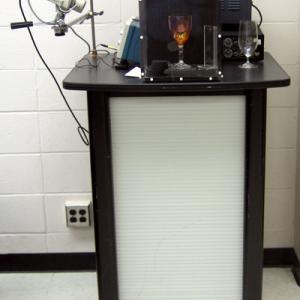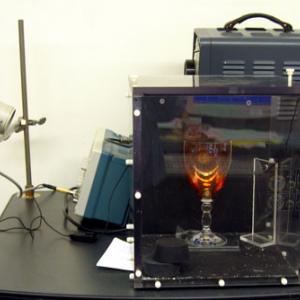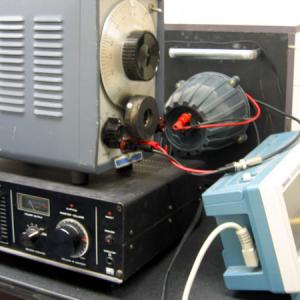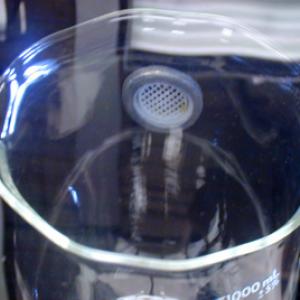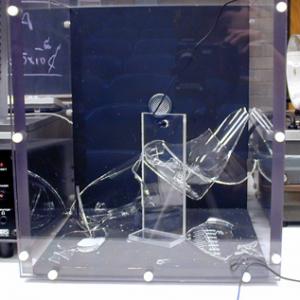College of Liberal Arts & Sciences
3D40.55 - Shattering Beaker
Video Credit: Jonathan M. Sullivan-Wood.
Mount the desired sized beaker in the enclosure on top of the rubber stopper. Use only 1000 ml beakers which should have a resonance around 850 Hz. Place the pour spout at 90 degrees to the speaker. Place the microphone at 180 degrees from the speaker and close to the beaker. Turn up the sound and find the resonance peak of the beaker by watching the oscilloscope. When the peak has been found turn up the amplifier suddenly and the beaker should shatter. OPTIONAL: The flexing of the beaker at resonance may be observed with the use of the strobe light. The Pasco wave generator works best for this demo.
NOTE: You must use brand new beakers to get this demo to work reliably.
If using the old generators... NOTE: Use the 600 ohm outputs on the wave generator. DO NOT allow the wave generator to warm up for long periods of time before doing the demo.
Wine glasses of different sizes are also available for this demonstration although you will have to do some preparation to find the resonant frequencies as they are more difficult to find than with the beakers. Use wine glasses without a lip on the rim. These will usually have several closely spaced resonant frequencies, however, only one will break the glass. These can only be broken using the Pasco wave generator.
- Bill Berner, "Resonant Wineglasses and Ping-Pong TM Balls", TPT, Vol. 38, #5, May 2000, p. 269.
- Haym Kruglak and Rene Pittet, "The Caruso Legend Lives On", TPT, Vol. 17, #1, Jan. 1979, p. 49.
- Willard C. Walker, "Demonstration Resonance by Shattering Glass with Sound", TPT, Vol. 15, #5, May 1977, p. 294.
- Thomas Rossing, "A Vintage Issue", TPT, Vol. 15, #7, Oct. 1977, p. 389.
- Kenneth D. Skeldon, Valerie J. Nadeau, and Christopher Adams, "The Resonant Excitation of a Wineglass Using Positive Feedback with Optical Sensing", AJP, Vol. 66, #10, Oct. 1998, p. 851.
- Wolfgang Rueckner, Douglass Goodale, Daniel Rosenberg, Simon Steel, and David Tavilla, "Lecture Demonstration of Wineglass Resonances", AJP, Vol. 61, #2, Feb. 1993, p. 184.
- Gordon E. Jones and W. Paul Gordon, "Apparatus for a Shattering Experience", AJP, Vol. 47, #9, Sept. 1979, p. 828.
- "Random Science", Uncle John's Bathroom Reader, p. 80.
- .Jearl Walker, "3.44, Shattering Wineglasses With Voice", The Flying Circus of Physics Ed. 2, p. 164.
- Julien Clinton Sprott, "3.9, Breaking a Beaker with Sound", Physics Demonstrations, ISBN 0-299-21580-6, p. 166.
- Peter, W. Tappan, "Shattering Goblets with Amplified Singing", Audio Engineering Society Preprint, 1973.
- Curt Suplee, "Resonance and interference", Everyday Science Explained, National Geographic, p. 62.
- Robbie Berg, "Shattering a Glass with Sound", Glass Shattering Demo Explanation, March 1, 1998.
- Julius Sumner Miller, Q173 & A173, Millergrams II – Some More Enchanting Questions for Enquiring Minds, p. 43 & 98.
Disclaimer: These demonstrations are provided only for illustrative use by persons affiliated with The University of Iowa and only under the direction of a trained instructor or physicist. The University of Iowa is not responsible for demonstrations performed by those using their own equipment or who choose to use this reference material for their own purpose. The demonstrations included here are within the public domain and can be found in materials contained in libraries, bookstores, and through electronic sources. Performing all or any portion of any of these demonstrations, with or without revisions not depicted here entails inherent risks. These risks include, without limitation, bodily injury (and possibly death), including risks to health that may be temporary or permanent and that may exacerbate a pre-existing medical condition; and property loss or damage. Anyone performing any part of these demonstrations, even with revisions, knowingly and voluntarily assumes all risks associated with them.
